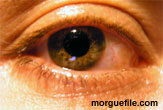
There's something in the faces of brown-eyed white men that makes them come off as more dominant than their blue-eyed peers, a new study suggests. And it isn't their eye color.
Czech researchers asked a group of 62 people to look at photos of 80 faces – 40 men and 40 women – and rate them for dominance. Then the investigators Photoshopped the faces so the brown eyes were replaced with blue ones and vice versa. A separate group of participants rated the altered images for dominance.
The results were the same in both cases: Faces of brown-eyed men were rated more dominant than those of blue-eyed men, even when their eyes weren't brown.
The effect, which didn't hold for female faces, may have something to do with the shape of brown-eyed men's faces, said study researcher Karel Kleisner of Charles University in Prague. On average, brown-eyed men had broader chins and mouths, larger noses, more closely spaced eyes and larger eyebrows than blue-eyed men.
More mysterious is why eye color would be so closely associated with facial type, the researchers say.
"It's really quite a surprising finding and certainly not one I would necessarily [have] expected," said psychologist Benedict Jones of the University of Aberdeen in Scotland, who was not involved in the study.
Jones said it would be important for other researchers to investigate the link to be sure it isn't "an idiosyncrasy of this particular sample of face images."
Sign up for the Live Science daily newsletter now
Get the world’s most fascinating discoveries delivered straight to your inbox.
Researchers believe blue eyes didn't exist until sometime between 6,000 and 10,000 years ago, when a genetic mutation emerged that reduced production of the brown pigment melanin in the iris. Before that, everyone had brown eyes.
There are now half a dozen different genes that influence whether someone will have blue or brown eyes. One possibility, according to the researchers, is that these same genes that confer eye color have other effects on the body or are in close proximity to other genes that do, such as those that regulate the production of testosterone. If two genes are close together on a chromosome, they are more likely to be found together in the same individual.
Kleiner said the "most elegant" explanation would be that children are treated differently depending on their eye color, and that this treatment leaves a lasting effect on their bodies.
"It is possible that subjects with blue eyes are treated as [small children] for a longer period than brown-eyed children," he and his colleagues write in the July issue of the journal Personality and Individual Differences.
Previous studies have found that blue-eyed boys of preschool age were more inhibited than boys with brown eyes. Although the effect seemed to go away within a few years, a person's social standing can alter their hormonal balance, which could have lasting effects on face shape, Kleisner said.
Kleisner said it's conceivable that women's sexual choices could be enhancing the link between eye color and face shape. He and his colleagues point to evidence that women have competing preferences for dominant males as sexual partners and less dominant males as mates. Men with intermediate features might get left out of the mating game.
- 5 Myths About Women's Bodies
- 10 Things Every Woman Should Know About a Man's Brain
- Odd Things You Didn't Know About You










